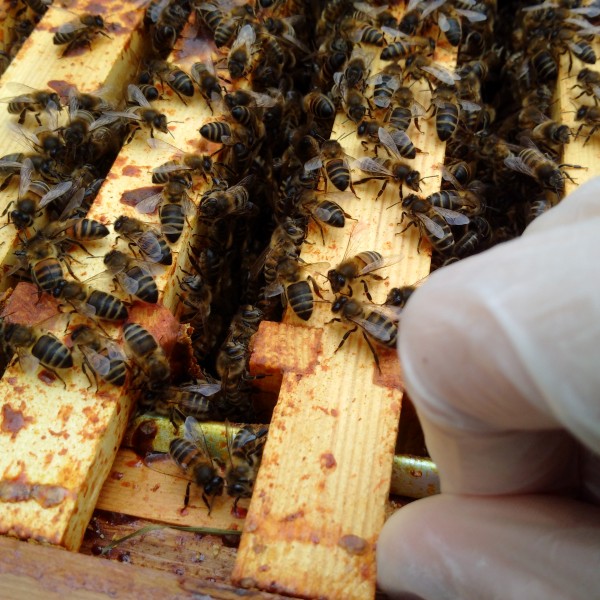I got my bees in early 2015. They seem to have a good first year, increasing from a nucleus to a full hive, eating voraciously and putting away stores. But, as winter drew in and the year came to a close, I knew that they, and I, would face the first real test.
In the first year of a nucleus, the most important thing is to get the colony from its state of being new but small to being an established hive, large and resilient enough to keep itself fed and warm all the way through to spring.
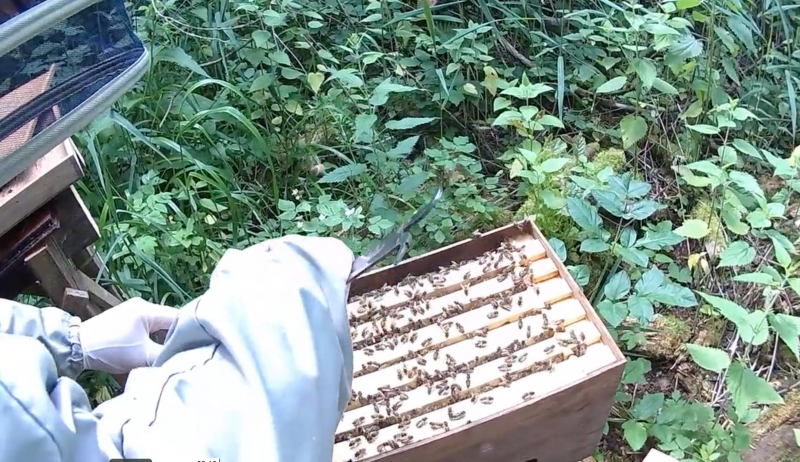
For this reason taking honey in the first year is wrong because they’re understaffed, working extra hard to get where they need to be. There is no surplus. And the honey would be made of the sugar syrup that I fed them anyway.
I gave them a brood box and a half, which means a large brood box to live in and a smaller super box (usually used for collecting honey) above that. They used both boxes for everything. The bees know best, or at least better than I do, so I left them to it. Toward the end of the year it looked like they were storing mostly honey in the upper super box.
In the wild honeybees will find a suitably homely looking branch and resolve to put a nest there. They will build honeycomb and fill it with stores and lay eggs. As the bees emerge, the cells are cleared out and the comb is used for storing honey and pollen and new comb is made. In this way they spend the year building slowly downwards and storing honey. In winter they huddle together for warmth at the bottom of the comb and slowly eat their way back up to the top.
The atavistic ways of the bees of old still resonate in hives of modern bees. Within their well-ordered hives they still come together for warmth when it’s cold. And still eat their way back up.
When the going’s good and the sun shines, the brood-and-a-half configuration works best with the smaller super box sitting on top of the brood box. The brood box is designed to be roughly the size of the ball of bees, which means that if the boxes were left like that over winter, the bees would start at the bottom, in the brood box, but by the time they’d got to the top, the cluster would be half in the super and half in the brood box, meaning that it would be very difficult to remove the super for whatever reason without chopping the colony in half. The cluster isn’t only where the bees are, it’s where and how they store their food and lay eggs.

Much better to start with the super on the bottom and end up with a cluster of bees where they belong come spring.

So, on the advice of my mentor, I decided to perform a pre-winter swap.
Turnaround
This swap is quite a serious operation. First off came the super, which was full of honey. With any luck this will become a regular occurrence if I decide to avail myself of a jar or two, but if it does I will first have emptied it of bees. Moving a heavy box full of bees any distance is daunting first time round. Doing the same with the much larger brood box no less so.
As I had taken my hive apart I thought I would do something I should have done long ago and rotated the it. I originally set the hive facing east-north-east because I thought that, pointing into the wildflower meadow, it would give the bees an easy time of it. Not so. They chose to make an immediate right hand turn and go straight up, out of a gap into the trees, into another (equally good) part of the meadow. I don’t know if they did this for the best crop, or because they hadn’t discovered that they could go straight out, or just for their own amusement, but they seemed pretty determined that this was where they were going to go.
So I rotated the entrance and reassembled my hive pointing south-south-east to give them an easier time. This caused no end of trouble.
It’s sometimes easy to forget what bees really are. They’re personable, docile, rarely aggressive, co-operative, and mystical in their behaviour, they achieve astounding things. They look about as excellent as an insect could hope to look, are furry and have a solid claim to the name ‘sky-bears’. Their only weakness is a susceptibility to anthropomorphism.
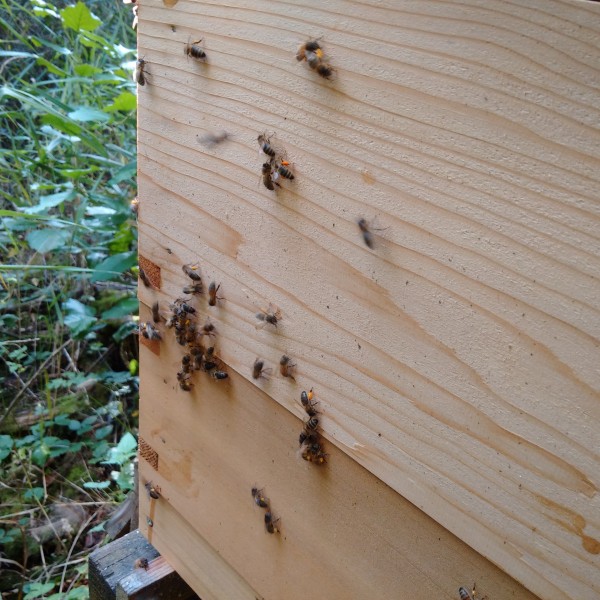
But they are simple creatures, who, when they discover that the door to their home is missing, don’t get curious or confused, they simply land where they remember they should land. Thus a large number of bees collected on the side of the hive, like idiots might, waiting to be let in. A short pheromone-sniffing expedition eventually saw them find the door and the way in.
When bees leave the hive for the first time they come out backwards and study the hive. They retreat a little distance, consider it from a new perspective and when they feel confident, retreat a little further. They did this when they realised the hive had moved. It’s fascinating to watch them looking so intently at their hitherto familiar home as they slowly back away.
And worth remembering that they do all this with compound eyes.
Midwinter
Winter may have closed in, but was never completely shut. A remarkably warm end to the year (many I spoke to remarked on it, one saying ‘it isn’t right. It isn’t right at all’) meant that my bees didn’t have such a hard time of their first winter as all that. I dropped in on Midwinter day to pass the time of day (not expecting to see any) and was shocked to see them out foraging. They were returning in high spirits with some kind of food (I don’t know what) and replenishing their stocks at the time when they should have been dependent on the previous year’s stores.

No time to get too comfortable, however, as January and February were very cold. No time to open up and inspect to see how they’re getting on. From time to time I would see dead bees littering the floor but a week later they would be gone. The death of some bees is to be expected over winter, and seeing that they were being given proper funerals by their sisters was a welcome sight.

They put up valiantly with the flooding.
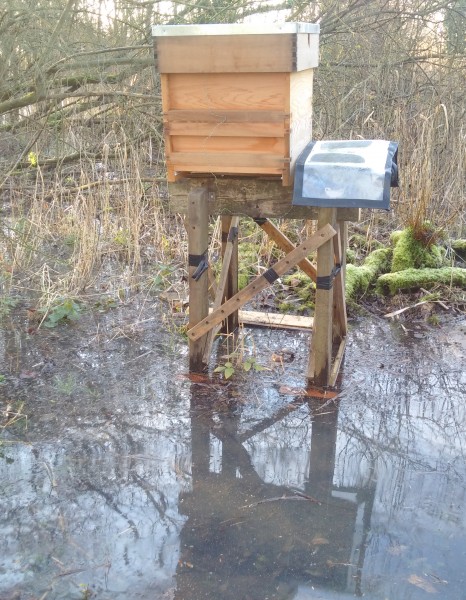
I don’t know if anyone else does this, but if you press your ear against the side of the hive you can hear the sound of the golden throng. It’s comforting to know they’re in there, working hard to stay alive. But buzzing to keep warm uses energy and, whilst I was confident that they had provisioned winter supplies in bounteous quantity, I didn’t know how quickly they were getting through them.
Giving a shock to an already stressed hive wasn’t very sensible, so I had to take it on faith that they would get through the winter happily.
Opening up
Late March felt the right time to open up and inspect my bees. I needn’t have worried, as I was greeted by a large colony.
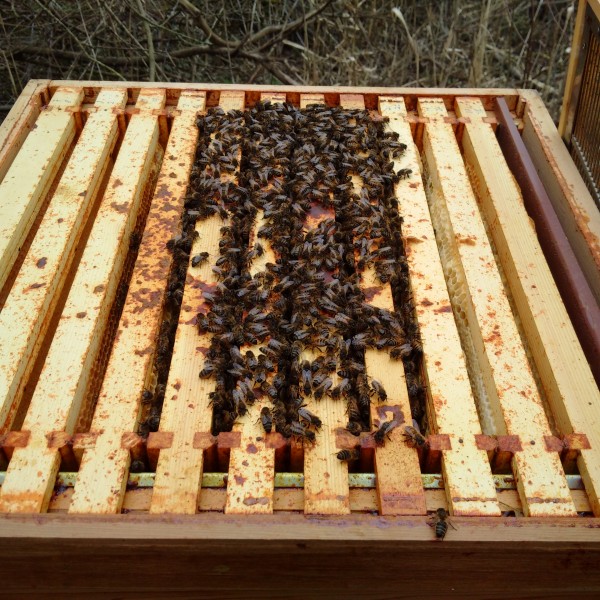
They were all huddled together, for warmth or out of habit, but sprung into action when I started the inspection. Compare the position of their wings before and after.
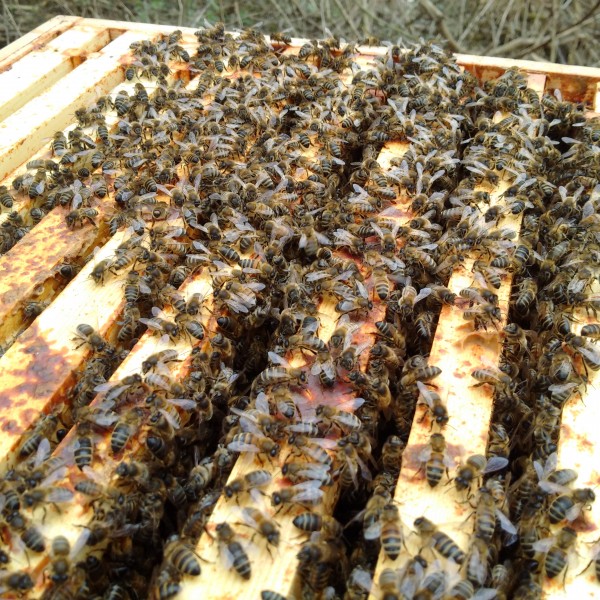
Looking through the brood box (for it was on top) I saw that they had a whole frame completely full of honey.
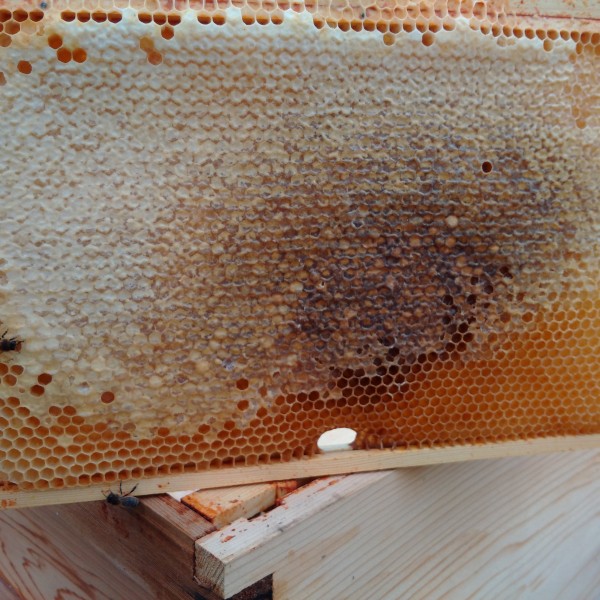
And a few others mostly full. There’s a phenomenon known as ‘isolation starvation’ in which the bees have plenty to eat but are so closely huddled that they never find it, and starve. Thankfully this didn’t happen.
And I was immensely pleased to see the herself the queen wearing a yellow spot. And a few babies only a few days old.
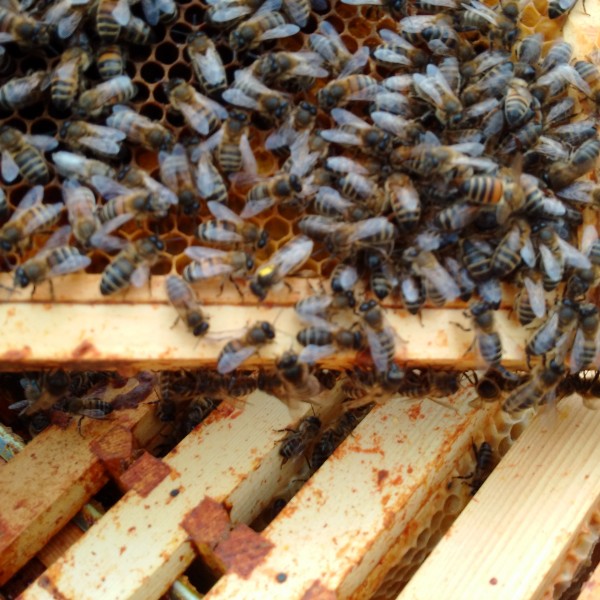
Yellow
The next day, being even more more springlike, I saw from a distance bright yellow insects descending on the hive. Initially worried that they might be wasps, I discovered my bees completely coated in bright yellow pollen that they had rather extravagantly rolled around in. I would have done the same.
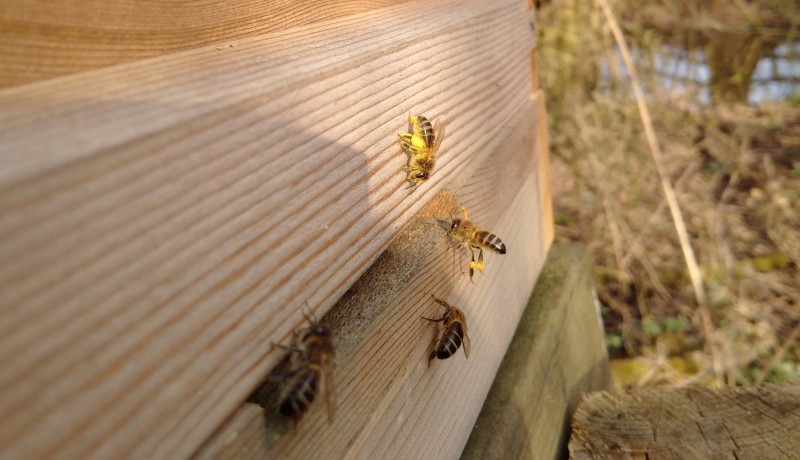
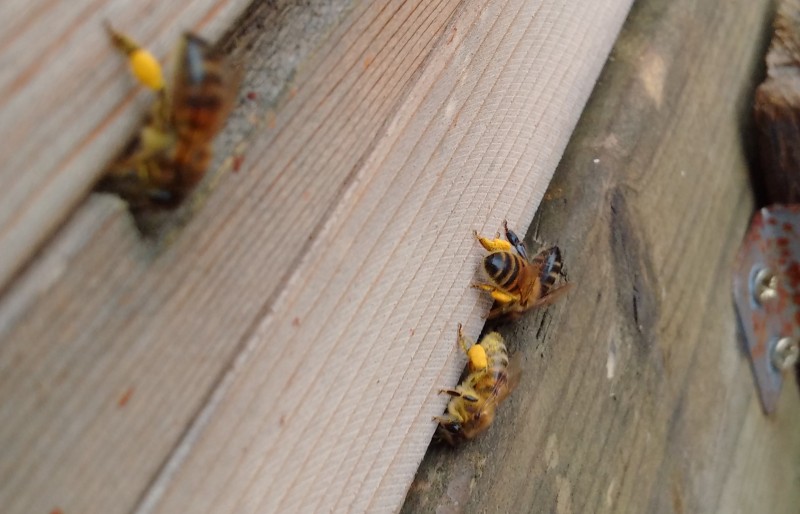
It is of course ridiculous to imagine that there’s any kind of bond between bees and beekeeper. But there’s certainly something (at least in the mind of the beekeeper) and it gave me great joy to see them, and interact with them, again.
They look like they’re set up for a good year.
